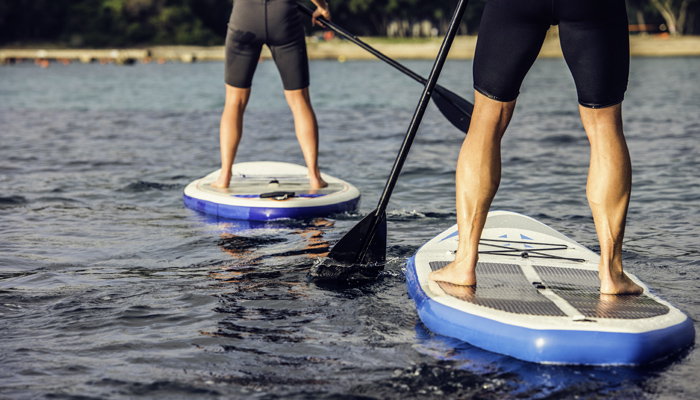Sailing Hacks
Read on for simple and effective boat hacks. Keep your mast step dry and get your boots on easier with our guide to all the best sailing hacks.
Here at Towergate, we started thinking – what do sailors do to make their lives on the water easier? We wanted to get straight to the source and ask those who know best so we asked the helpful folk on the Yachtsandyachting.com forum. Here’s what they recommended:
Protect your shrouds with sections of bike tubes
Dinghy sailors in particular will be familiar with the problem of split pins on shrouds becoming worn or catching on other parts of the boat or clothing. Many sailors wrap tape around the shroud plate and pin however, there’s a more permanent yet equally cost effective method of protecting them.
“Mister Nick” says: Use bike inner tube and slide it onto the shroud when you rig the boat. Stops anything catching and stops the split ring getting bent or pulled out, plus it's easier to remove than tape and reusable.
Dry out the mast step in your Laser using a jug mop
Lasers are one of the most common dinghies on the water. Almost as common as the problem of keeping your mast step dry when you’ve brought your boat ashore and need to wash and store it. If you store your Laser with a mast step full of water, it can freeze in cold conditions, expand and cause a split. This in turn would let water through the deck and into the hollow hull. There’s an ideal cheap household item which can help with this.
“Jeffers” says: If you have a Laser (or similar that has a 'pot' for the mast step) you can keep it dry by either using a Jug Mop (cost about 70p from many kitchen retail outlets) or by getting a length of dowel or an old batten with a bit of sponge attached to the end.
Use plastic bags to help get boots on over the top of your dry suit
Anyone who’s ever tried to wrestle on wetsuit boots or boots over a dry suit will understand that it’s not exactly like slipping into a pair of flip flops. But your days of struggling may be over thanks to this helpful tip involving something we all have plenty of lying around.
“Laser193713” says: Tesco bags (other brands are available) to put over your drysuit socks when putting your boots on top. No more tugging and struggling. Once the boots are on always pull the plastic bags out by tearing them so that the boots grip with the drysuit making your footing much more steady. You also look less silly than having two bag handles hanging out of the tops of your boots!
Use stronger reusable bags to hold wet kit in your car
Sticking with handy uses for carrier bags, many supermarkets and other retailers offer stronger, woven plastic bags for shoppers to reuse. In addition to being ideal for carrying heavy shopping, they’re also handy for holding wet kit and saving the back of your car from getting damp.
“Winging it” recommends Tesco and Ikea bags in particular!

Need to make a quick fix? Get your epoxy putty from an unlikely retailer...
Who’d have thought it that Lidl would be a favoured retailer of sailing maintenance materials?! For making quick repairs, you can’t beat epoxy putty.
Hopefully you don’t get through too much of it but if you do, “Winging it” has this advice: Lidl's epoxy putty is great for instant repairs and way cheaper than you will find anywhere else.
IMPORTANT: If you're making repairs to your boat which would affect its seaworthiness or the results of a marine survey, always consult a specialist and use approved materials.
Get buffing!

This great tip was given to us from our friends at Boats and Outboards.
Once an older boat’s gel-coat begins to look powdery and dull, it is usually down to the organic oxidization of the boat’s fibreglass. This is not rare for an ageing boat; however, the look of oxidization can be managed by regular waxing. And though it may be helpful, this is only a cosmetic fix. If your boat’s finish has deteriorated too much, it will increase the rate at which the fiberglass itself goes.
If oxidization has already happened, you will have to buff the oxidized layer and re-wax the surface. Buff the dull finish away using a low-speed buffer and the necessary buffing compound. As you’re working on an important part of your boat, be sure to start with a small practice area before you move on. Begin slowly with your buffer speed, compound and pressure, and increase all three as needed. Work on a small area at a time, make sure to keep the buffer moving. Don’t expect a high-gloss surface from buffing alone – the boat will still look a little dull. Once the chalkiness has gone, you’re ready to apply new wax and enjoy your shiny boat! Use wax regularly to keep your boat protected and at its best.
We’d like to say a huge thanks to those who contributed ideas on the Yachtsandyachting forum. We hope these tips have been useful. If you have any more ideas, feel free to post them on our Facebook profile. Happy sailing!
Boat insurance from Towergate
Find more information on our boat insurance see our boat insurance or phone 0344 892 1987.
About the author
Adam Summersby is a respected leader with 11 years’ varied experience in niche personal and commercial lines insurance, including caravan, site operators and excess reimbursement, with proficiency in leadership, sales and account management.
Date: January 05, 2014
Category: Boat
















